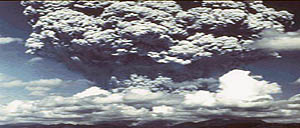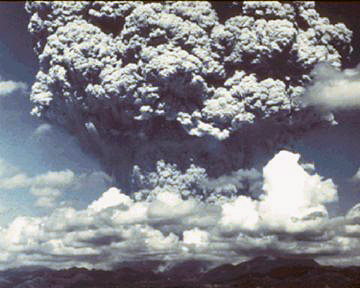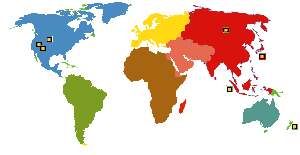Could We Survive a Super Volcano?

Observing the volcanic ash cloud and the disruptions to northern Europe from Iceland’s recent volcanic eruption has caused me to think about other scenarios which would have grim and wider consequences from an event called a Super Volcano.
Our experiences with volcanoes have for the most part been with classifications that are somewhat tame in comparison to some events that have occurred in the distant past. I recall having observed a volcanic effect following the eruption of Mount St. Helens in 1980. At the time I was living in Massachusetts, about 2,500 miles from the volcano. Within a few days of the eruption, the ash reached the east coast of the US, and within 2 weeks was circling the globe up in the stratosphere (between 6 and 31 miles altitude). I clearly remember the reddish skies from the ash up in the high atmosphere, as well as spectacular orange and red sunsets. The ash remained in the atmosphere for years.
Mount St. Helens was minuscule compared to the most dangerous type of volcano, the super volcano. Try to imagine an eruption that would be up to 10,000 times stronger than a Mount St. Helens. One that would threaten the very survival of all humankind. The super volcano is quite likely the worse case scenario of any and all possible disaster scenarios, in my opinion, mainly due to the fact that there is absolutely nothing that we can do to deter or prevent it. It’s devastation ranks up there with a large asteroid hit, world nuclear war, and world wide deadly pandemic.
Super Volcano Effects
- Magma would be hurled 30 miles up into the atmosphere
- Complete devastation of an area the size of North America or Europe
- Volcanic ash would cover the devastated area to depths ranging from hundreds of feet to as much as six inches – thousands of miles away
- Anything within 500 miles of the eruption would be completely destroyed
- Sunlight would be blotted out for months followed by a dim and cold volcanic winter lasting for several years
- Global temperature would drop 20 degrees
- Mini Ice Age
- 75% off of all plant species would die off
- World agriculture would be devastated
- Mass starvation
- The very survival of human civilization would be threatened
Super Volcano locations include
- Yellowstone in Wyoming (USA)
- Long Valley in California (USA)
- Valley Grande in New Mexico (USA)
- Lake Taupo in New Zealand
- Aira in Japan
- Lake Toba in Sumatra
- Siberian Traps in Russia
An alarming statistic regarding Yellowstone is that it’s eruption cycle is about 600,000 years. That in itself is not alarming, however the fact that the last eruption was 640,000 years ago is alarming. Yellowstone is 40,000 years overdue!
When considering the affects that such an event would have upon the world, it is nearly incomprehensible to create a survival plan. When considering Yellowstone for example, those that live in Idaho, Montana, and Wyoming will have a terrible if not impossible chance of survival. The entire United States will be covered with ash, probably at a minimum depth of 5 inches. How could one expect a chance to survive the effects of such a catastrophe? You may decide not to consider a plan of action due to the odds and magnitude of the situation. Well, you may be right if you live in the region, however there is always hope and a way for those living further away.
It seems that the key to surviving a super volcano begins with living in a safe and secure location, having several years of food and water, and the supplies and skills to grow your own food when the earth finally allows it once again.
The point is, while we are seeing the effects of Iceland’s volcanic eruption, it makes me realize the massive power of mother earth. Don’t be lulled into ignorance of what could happen around us. Make a plan for your survival. Check your preparedness plans, even if they seem futile in the face of catastrophe. Begin by storing food and water. Buy extra of what you normally eat and begin an inventory rotation. It’s the responsible thing to do.


